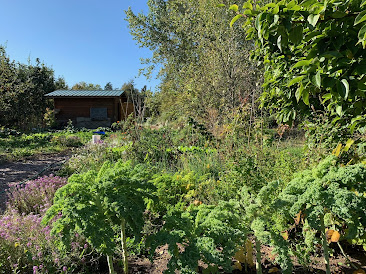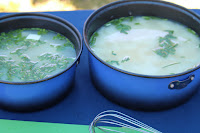Today, we were back together again in the Orchard Garden, working in two groups to collaborate and plan activities for the Summer Solstice Celebration on Thursday, June 23rd, and for the final workshop of the Orchard Garden workshop series on Saturday, June 25th.
Summer Solstice Celebration Planning:
The Thursday group is excited to celebrate the Solstice with a day of Exploring your Senses in the Garden.
We have planned a variety of activities which will engage each of the senses. These activities include storytelling, bird watching, garden tours, wildflower seed bomb making and a cooking demonstration. All of this educational enthusiasm will be interspersed with snacks and music. We are looking forward to a wonderful day in the Garden!
Saturday Workshop Planning:
The Saturday workshop group has planned an Arts in the Garden workshop that has two main activities: making willow dreamcatchers from Anishinaabe teachings, and painting in the garden with natural tools and dyes. Today, we all brought materials we had harvested/prepared for the workshop and tested out our activities in action.
Shelby brought willow that she harvested as well as sinew and beads and demonstrated how to bend and tie the willow to create a teardrop or circular frame. She then modeled the technique of how to knot and weave the sinew to create a web inspired by the beauty and teachings of a spider’s web. We were so grateful for this wonderful experience and we can’t wait to share it with others during the Saturday workshop.

Maggie and Gideon learn how to make willow dreamcatchers.
The rest of us brought natural dyes that we had prepared from blueberries, beets, spinach and matcha, turmeric, cabbage, and coffee. It was exciting to see how well the natural dyes turned out. We experimented with creating paint brushes from grass and other plant offerings from the garden and we coordinated how to use the garden’s tables, benches, and tents to enable independent and communal painting during the workshop.

Sample of the natural dyes with which we experimented.
Gideon:
Participating in the Saturday Workshop planning process was a great example of teacher collaboration. I wouldn’t have come up with these learning experiences independently, yet once my colleagues put forth the initial ideas, each of us were able to contribute based on our previous experiences as educators and learners. The B.C. curriculum spans a vast range of concepts across many disciplines, and it is a challenge for any single teacher to try and plan engaging units and lessons independently. I must admit that I have a tendency to insulate myself and try to do just that - work through everything myself. Collaborating to plan the Saturday Workshop helped show me that there is no need to fear judgment or criticism of ideas when working as part of a caring and reciprocal teaching community. We frequently shared and revised ideas in pursuit of developing an engaging and effective learning activity.
Today was also another important reminder of the necessity to try any activities prior to using them in a lesson. There is a large gap between coming up with an idea that connects to the curriculum and actually making that idea feasible in practice so that a given audience can extract meaning through engaging with it. As Shelby led the rest of our group in making willow dreamcatchers, we learned that there were several key steps where we participants could get confused and make errors. Furthermore, we learned that in order to complete the activity within an hour as hoped for, we need to instruct participants to limit themselves to 9 knot points around the willow hoop. Those of us who made more knot points on our dreamcatchers found ourselves working well past an hour.
When we started experimenting with creating mark-making tools, we soon learned that it was very challenging to create tools that made interesting and effective marks using our natural watercolour paints. We had initially thought that making a diversity of mark-making tools would be an engaging art activity; we found through experiencing the activity, however, that the greater engagement came from having a tool that could effectively use the natural paints we had created. We found that it was more successful to create denser tools that mimicked paintbrushes which worked well with the natural paints and as a result, made some small conceptual revisions to the activity that had a large impact on the overall experience of the activity.
Beyond this, we spent a significant amount of time deciding how to use the physical space of the Orchard Garden effectively to carry out these two activities. This reminded me a great deal of lesson planning for the classroom during my practicum. I would start with an idea and then have to think through the small details of how materials would be distributed and where students would be at different parts of the activities. When I took the students out to the schoolyard for learning activities, the importance of these planning decisions were amplified. The students’ attention were easily grabbed by all of the sensory stimulations of the outdoor environment and I had to have extremely clear and simple instructions each step of the way to keep their attention. Today, we got to think through these small logistical decisions as a group in hopes of creating an engaging and educational workshop on Saturday.
Peter:
Planning to teach lessons in a garden environment has many similarities to the classroom and many unique challenges. The advantage of the garden is that it is a pre-built interactive classroom, and our job as teachers is to find ways to ensure an engaging experience with our students.
In planning the Summer Solstice Party, the group quickly came to the consensus that engaging our students through focusing on the senses was a beautiful way to take advantage of all the learning opportunities the garden presents.
As someone who has cooked professionally, and taught many cooking classes in the past, my mind immediately turned to food. Now, figuring out what I could demonstrate using the ingredients that were ready to be harvested, and that I could demonstrate in the garden was a bit of a challenge. This task reminded me of the experience of helping to plan a field trip during my practicum. While you know the destination you wish to arrive at with your students, you must plan with all the risks and challenges in mind, and still make it engaging and educational.
After considering various options, and having numerous failed experiments littering my kitchen counter, I settled on demonstrating a garden herb hummus. Hummus is packed full of protein and can be flavored with a variety of herbs from the garden. That it is vegan also allows for the greatest number of participants to try the finished product. While I have prepared the bulk of the hummus in my kitchen for tomorrow's festivities, I will be doing a demonstration using a mortar and pestle in the garden.

The thought of being able to use food and gardening to educate students on a variety of subjects truly excites me. Talking about the origin of ingredients, their historical context, the biology of how they've grown, or even the scientific principle of emulsification can all come from a garden lesson about hummus. It just goes to show the old adage that Nature is the best teacher still holds true.
Garden Herb Hummus Recipe
Ingredients
1 Cup of Chickpeas with cooking water
1 Cup of Chickpeas drained
¼ cup of lemon juice
⅕ cup of Olive Oil
2 Tablespoons of Apple Cider vinegar
1 ½ Tablespoons of tahini
Herbs for flavor (I used garlic scapes, chives, mint, and oregano from the garden)
1 clove of garlic (omit if using garlic scapes)
Salt, Pepper, Cumin, and Chipotle Powder to taste
Add to your blender in the order above. If you're using a food processor the order you layer the ingredients is less of an issue. Blend until your desired consistency. Enjoy!
I leave you with a little poem I have written and that has been published in a few places. The name of my cooking class business is Pasta Boy Peter - Eat with those you Love TM and that spirit comes from this poem. I leave it as a little blessing to all of you who visit the garden.
Eat with those you Love and you will stay in Love
Eat with those you Like and you may fall in Love
Eat with those you hate and you may learn to Tolerate
By Peter Ciuffa



.jpeg)

.jpeg)
.jpeg)
.jpeg)


















.jpg)







%20-%201.jpeg)
%20-%201%20(1).jpeg)
